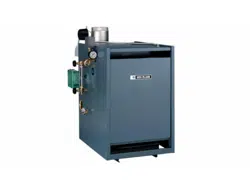Loading ...
Loading ...
Loading ...

Part Number 550-142-303/1120
7
EG
/
PEG sEriEs 6
•
EGH sEriEs 5 Gas-firEd boilErs — boilEr manual
Products to avoid
Spray cans containing chloro/uorocarbons
Permanent wave solutions
Chlorinated waxes/cleaners
Chlorine-based swimming pool chemicals
Calcium chloride used for thawing
Sodium chloride used for water softening
Refrigerant leaks
Paint or varnish removers
Hydrochloric acid/muriatic acid
Cements and glues
Antistatic fabric softeners used in clothes dryers
Chlorine-type bleaches, detergents, and cleaning solvents
found in household laundry rooms
Adhesives used to fasten building products and other similar
products
Areas likely to have contaminants
Dry cleaning/laundry areas and establishments
Swimming pools
Metal fabrication plants
Beauty shops
Refrigeration repair shops
Photo processing plants
Auto body shops
Plastic manufacturing plants
Furniture renishing areas and establishments
New building construction
Remodeling areas
Garages with workshops
Buildings under construction (where air is contaminated with
particulates)
Figure 3 Terminations with Type B vent fitted with listed cap,
provided vent is at least 8 feet from any vertical wall or
similar obstruction
Vent System (continued)
Chimney or vent requirements
1. Venting must be installed according to the National Fuel Gas Code,
ANSI Z223.1/NFPA 54 – latest edition and applicable building codes.
Canadian installations must comply with Natural Gas and Propane
Installation Code, B149.1 or B149.2 Installation Codes.
2. See “Ratings” on page 39 for minimum chimney or vent sizes.
Chimney or vent termination:
• A chimney, or any vent other than a Type B vent with listed vent
cap, must extend at least 3 feet above the highest point where it
passes through a roof of a building, and at least 2 feet higher than
any portion of a building within a horizontal distance of 10 feet.
• TypeBventswithlistedcapsmayterminateasinFigure3ifno
closer than 8 feet from a vertical wall or similar obstruction.
• Otherwise,TypeBventsmustterminateatleast2feetabovethe
roof penetration and at least 2 feet higher than any portion of a
building within 10 feet.
• Ensure proper clearance above grade or snow line. Keep vents/air
intake area clear of accumulating snow.
3. A lined chimney is preferred and must be used when required by
local, state, provincial and national codes, laws, regulations and
ordinances. Vitreous tile linings with joints that prevent retention
of moisture and linings made of noncorrosive materials are best.
Advice for flue connections and chimney linings can be obtained
from local gas utility. Type B double-wall metal vent pipe or single-
wall vent pipe may be used as a liner.
4. Cold masonry chimneys, also known as outside chimneys, typically
have one or more walls exposed to outside air. When any atmospheric
gas-fired boiler with automatic vent damper is vented through this
type of chimney, the potential exists for condensation to occur.
Condensation can damage a masonry chimney. The following are
recommended to prevent possible damage.
a. Line chimney with corrosion-resistant metal liner such as AL29-4C®
single-wall stainless steel or B-vent. Size liner per National Fuel Gas
Code ANSI Z223.1/NFPA 54 – latest edition.
b. Provide drain trap to remove any condensate.
5. Where two or more gas appliances vent into a common chimney or
vent, equivalent area should be at least equal to area of vent outlet
on largest appliance plus 50 percent of vent outlet area of additional
appliances.
Air contamination
1. Please review the following information on potential
combustion air contamination problems.
2. See Table 3 for products and areas which may cause
contaminated combustion air.
To prevent potential of severe personal injury
or death, check for products or areas listed
below before installing boiler. If any of these
contaminants are found:
•Removecontaminantspermanently.
— OR —
•Isolateboilerandprovideoutsidecombus-
tion air. See national, provincial or local
codes for further information.
Prepare boiler location (continued)
Table 3 Contaminants to avoid
Loading ...
Loading ...
Loading ...
